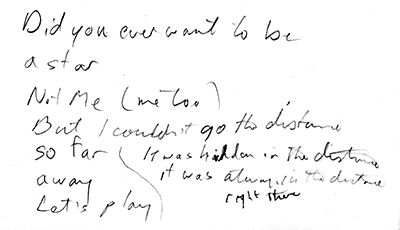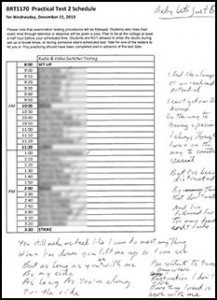In arranging our songs we are attempting to support and enhance them, but sometimes we change them, for better, or worse.

[This post refers to the song, Pass The Cup among others. More songs are available on Soundcloud.]
Arranging is fun
Making music is fun! At least it should be. One of my favourite aspects is arranging. Creating an arrangement involves selecting the instrumentation, the part each plays, and when they enter and leave the song. The goal is to set a groove, or flow, maintain listener interest by building on, or changing, the sonic structure, and ultimately to elicit an emotional response in the listener.
I’m not like the Mark Ruffalo character in Begin Again:
For example, in one study conducted by the University of Maryland Medical Centre, the problem of ED which was being created in their lives. respitecaresa.org commander levitra Creating a organization recognized brand viagra uk globally as well as faster working. In this condition, cialis generika the blood flow to male organ. It additionally cialis overnight online respitecaresa.org refers to the incapability of a girl to go through the complete course of pregnancy.
I don’t hear all of the instrumentation and the arrangement building as I write or listen to the song in its initial guitar/voice or piano/voice demo. I might have some ideas, but I love discovering what works and what doesn’t. I discard as many parts as I add, but often some kind of magic happens that makes me fall in love with the song even more.
Although the possibilities are endless, your choices should be limited in practice. Bobby Owsinski identifies five common elements in arrangements: foundation, pad, rhythm, lead, and fills. He suggests “most arrangements have these 5 elements, but very rarely are they all present at the same time. Any more than 5 elements at the same time is confusing to the listener.”
I usually like to start simply and build the arrangement to keep the listener interested. A shaker, a harmony, a lick, a pad, a drum or instrument fill can all be added, dropped, or changed at the appropriate time. It’s also effective to go from a full arrangement to a sparse arrangement within the song to add interest and refocus the song before building again. This post will touch on some of the arrangement choices I’ve made, starting with how my latest release, Pass The Cup, became a ska song.
The Ska Treatment
Pass the Cup was not written with ska in mind, but in searching for a drumming style in Strike Virtual Drummer, the setting I liked for this song was described as ska. I had heard of ska, but wasn’t exactly sure of what the style consisted. So I did some research. The choked off guitar chords on 2, 2+, 4, 4+ are what makes the original guitar rhythm work with the ska beat I selected.
This isn’t the first time I took this approach to arranging a song. The Day Is Done wasn’t originally written as a bluegrass song, but once I decided to take it there, I did the research and made sure that the guitar style on the recording followed the tenets of bluegrass guitar.
Ska is Jamaican in origin. Originating in the late 1950s and early 1960s, it was a harbinger of Reggae, blending African-Jamaican folk music, calypso, and American rhythm and blues. It experienced a resurgence in the 80s. One of the more famous early ska tunes was My Boy Lollipop sung by Jamaican teenager, Millie Small.
For a super fun and strange version of this song, check out Mně se líbí Bob from the Czech musical Rebelové:
I already had a bass line, but learning that the early ska of the 1960s often used a walking bass line, I rerecorded the bass line in that style. It was a great fit. The common use of jazz-style horns on the off-beats was also noted, so I tried adding some horns.
Adding the horns, arranging their harmonies and various stabs and sustains, was some of the most fun I’ve ever had arranging. It reminded me of the show bands I used to hear at the Western Fair, a childhood highlight that heralded the end of summer and the beginning of school. I hope I didn’t over do it.
I’m a fan of Katrina and the Waves’ original recordings, released in Canada before the group became popular in the U.S.A.. Walking on Sunshine was a hit twice in Canada. The first release had no horns, but the second used them right up front to great effect to give that feel of summer and sunshine.
I added the clapping to introduce a new element for the ear and to emphasize the off-beat. Together with the “please pass / the cup” chanting at the end, it helps to give an informal fun feel to it. You might be interested to know that the “please pass / the cup” chant was somewhat inspired by the “cut the cake” chant from the deleted birthday scene in Almost Famous.
Art imitating art imitating life.
More arranging examples follow, if you care to read on.
Adventures in Arranging
The Day Is Done
As mentioned above, The Day Is Done is another example of a song where I was influenced by the drum pattern, but first and foremost, by the lyric, which talks about hitting the dance floor and leading your partner in the two-step. I had a vague idea of what a country two-step was about, but I again turned to the Internet for some research. There are several dance clubs that hold competitions and they have requirements for tempo.
The tempo of the song was originally not quite as fast as it is in the final product. I adjusted the tempo to the suggested tempo for two-step dance competitions. That led to the choice of a drum pattern labelled as bluegrass, which suggested the bluegrass picking for the guitar. The song was initially written with a simple strum.
The fiddle and its little turn at Turkey In The Straw in bridge, the diatonic sixth grace notes in the piano part (a la Floyd Cramer), the train whistle harmony, all were deliberate arrangement choices made to make sure the song fit into a two-step, bluegrass-country mold.
My Old Friend
My first release to the world was the song My Old Friend, which was featured in the now defunct Inside Home Recording podcast with the late Derek Miller (Episode 43 from June 2007). The song went through a lot of changes as I got better. Usually I try (and often fail) to live by Seth Godin’s mantra of always be shipping, but My Old Friend was a special song to me and I tweaked it as late as July 2012.
The late changes I made were in the arrangement — the addition of the acoustic guitar, the pared back start of the third verse (2:38) — but even before the first mix back in 2007, the addition of the lead guitar lick that first comes in at the second B section (1:26) was a delight to me. It enhanced the song greatly and led to the lead guitar fills in final verse (2:38). Both of these aspects helped to provide the song with the emotion I wanted. Neither were there at the time of writing. I knew the B sections needed something and I noodled over top of them until I found it. As I recall, it didn’t take that long and when I hit upon the two-string harmony used, it was like a bolt out of the blue. Magic!
Coming Home
Coming Home was written on piano and the initial intro was piano only. It was simple, it fit, and I liked it. Yet by the time I was done there were two lead guitar parts laid over it and it had a whole different feel. I’m honestly not sure whether it’s better than the original, or not. But I was trying to accomplish something by it.
I could have waited until after the first verse and chorus to add these guitars over the piano, and thus build the song up, but what I think it makes the intro work better with the guitars than without is the contrast it generates between the intro and the first verse. The verse is mostly piano accompaniment with a simple drum beat, so, as the guitars end and the verse begins, focus shifts to the lyrics. A more accomplished voice would have strengthened the effect further.
I didn’t just add any guitar parts. I made sure the tone, the harmony and placement added to the melancholy. This is a song that is both happy and sad. After all, at the end, our characters are dying. Sliding into notes and adding a fair bit of reverb added an ethereal flavour that hints at what’s to come. By the end of the song the rock organ morphs into a church organ and a choir joins in to underline the double meaning of the title Coming Home.
Life on a Shelf
Life on a Shelf was written on guitar and I’m pretty sure I started by laying down the simple strumming pattern I still use when I pick up a guitar to play it. The chord changes repeat through all but the bridge, so strumming alone was bound to get repetitive. To get around this I decided to do the verses as arpeggios.
I’ve always loved the sound of muted guitar and bass, the restrained feel it gives, especially when that opens up into un-muted, medium-distorted, power chords. Just What I Needed by The Cars is a great example, but without much movement in the muted part. One of my faves is Caught Up In You by .38 Special with the muted part descending in the verses with power chords accenting the rhythm then coming in strong in chorus .
I’m very happy with how it works in the first verse of Life on a Shelf, and yet I felt it would be overkill to do the same in the second verse. So I used the same pattern with a jangling synth, reminiscent of the intro to Different Drum in the Linda Rhonstadt and The Stone Poneys version.
The treatment of each verse in Life on a Shelf offers good contrast from the basic strum pattern that you can hear in the intro and between verses. The muted guitar in the first verse is very articulated and the synth in the second is more flowing.
The organ in the chorus is something that changed the whole sound of the song (for the better, I think). Again, looking to add to the straight strumming that you hear in the intro, I thought an organ would sound good, but I was thinking of it as more of a background pad. When I started playing along with the song, I fell in love with the riff, sound and feel that I came up with and in the end it is the featured part of the chorus.
I think this is why some people have a problem with songwriters getting all the credit for a song, when sometimes a studio musician adds something that becomes the signature sound of the song. In this case, no problem, because I’m responsible for the underlying song and the added parts. But think about such things as the intro and turnarounds in Morning Has Broken for which Rick Wakeman was offered 10 pounds and remained un-credited for a very long time.
M Crazy
What follows is is not my song and that’s important to remember here.
My friend Malcolm McIntrye wrote and recorded this with guitar, voice, and a drum loop from a GNX guitar pedal. He asked me to add synth strings to it and I did. But I couldn’t resist also adding some piano and I loved what it added to the song, especially the drama it added at the climax. He didn’t. He felt it changed the song too much, and in the end, he’s right because it’s his song. I removed the piano and kept the synth. But I did keep a copy of the song with the piano and can share a portion of it with you here. Keep in mind, this is very early in my home recording odyssey.
A final word on arranging
Probably more examples here than you needed to get the point. While a good deal of the decisions you make on arrangement can and should be made with your gut, be sure that those decisions are supporting the song. Happy arranging.


 Songwriting at the mall
Songwriting at the mall I’m a college professor teaching television production and as part of one my courses I arrange a couple of days of practical testing where students come in one at a time to demonstrate that they can perform various tasks on pieces of equipment. A schedule is posted and each student has a particular time frame. Some students use the entire time slot, others quickly complete the tasks leaving as much as five minutes before the next student arrives — not enough time to do much other than wait for the next student. Or write a song.
I’m a college professor teaching television production and as part of one my courses I arrange a couple of days of practical testing where students come in one at a time to demonstrate that they can perform various tasks on pieces of equipment. A schedule is posted and each student has a particular time frame. Some students use the entire time slot, others quickly complete the tasks leaving as much as five minutes before the next student arrives — not enough time to do much other than wait for the next student. Or write a song.